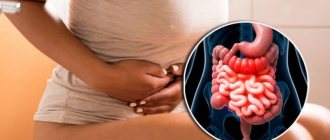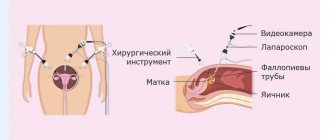Mild, moderate or severe pain in the lower abdomen in women, the causes of which can be different, is a very common complaint received from numerous patients - both very young and elderly. In some cases, although these are unpleasant, they are normal variants that do not indicate any pathologies. But, often they are one of the symptoms of a large list of diseases. First of all, gynecological health is under suspicion, although pain can also arise for other reasons. In any case, you need the help of specialists who will identify the source of the painful condition.
Lower abdominal pain. Causes: gynecological diseases
The content of the article
Pain in the lower abdomen during menstruation
Dysmenorrhea is one of the most common pathologies that causes pain in the lower abdomen. Dysmenorrhea can be a primary cause, or secondary when diseases of the female genital organs already exist.
In severe cases of dysmenorrhea, in addition to abdominal pain, vegetative symptoms appear, such as:
- nausea;
- vomit;
- headache;
- general weakness;
- nervousness.
Endometriosis is a cause of pain in the lower abdomen
Endometriosis is a disease characterized by the appearance of the lining of the uterus outside the organ itself. The mucous membrane grows and undergoes the same changes as the uterine mucosa during the menstrual cycle.
Endometriosis
Monthly bleeding of endometriotic tissue very often causes pain in the lower abdomen. Abdominal pain usually begins a few days before the start of menstruation.
Other symptoms of endometriosis include:
- painful sexual intercourse;
- lack of pregnancy (infertility);
- dysmenorrhea.
When pain is not associated with pathology
Sometimes it is unnecessary to panic, since discomfort in the lower abdomen is due to physiological reasons:
1. Approaching menstruation.
7-10 days before its onset, the sensitivity of the vaginal walls increases several times. A woman complains of heaviness and bloating in her abdomen. Therefore, for many, intercourse during this period will be unpleasant.
2. Too passionate or even rude actions of the partner, lack of foreplay.
Excessive pressure on the vaginal walls and internal organs causes nagging pain after intimacy. You can avoid this by spending enough time on foreplay and talking with your partner about your feelings and preferences.
3. Poorly chosen position and impressive penis size.
Although it is believed that there is no anatomical incompatibility between partners, since the vaginal mucosa is extremely elastic, the first intercourse, when “getting used to” each other, can be very painful. Incorrect posture will complicate the situation. The use of lubricants and the choice of positions in which the woman herself regulates the depth of penetration will help here.
4. Adhesions in the pelvis after previous illnesses, difficult childbirth or operations.
In this case, pain can be observed not only after intercourse, but also in everyday life, even when the weather changes. Look for a position in which the discomfort will go away, use gels and lubricants.
5. Congestion in the pelvic organs due to irregular sexual activity and muscle spasm after orgasm.
The unpleasant sensations are short-term and go away on their own.
Inflammatory diseases of the pelvic organs
Pelvic inflammatory processes can be caused by numerous pathogenic microorganisms: bacteria, viruses, protozoa or fungi.
The main symptoms of inflammation of the female genital organs include:
- stomach ache;
- slight bleeding from the uterus and vagina;
- soreness of the uterus upon independent palpation of the abdomen.
When there is inflammation of the appendages on the right side, the pain that appears must be differentiated from acute inflammation of the appendix.
Cervicitis
Cervicitis is a disease that leads to severe inflammation of the cervical canal. The cervix is a natural barrier that prevents pathogens from entering the woman’s reproductive system. In some cases, for example, when the mucous membranes are damaged, microorganisms enter the tissue of the cervical canal and provoke the development of infection.
There are two types of cervicitis:
- Exocervicitis is inflammation of the outer segment of the cervix.
- Endocervicitis is a lesion of the inner mucous layer of the cervical canal.
A patient suffering from cervicitis has the following complaints:
- cutting pain in the lower abdomen and vagina;
- discomfort in the lumbar region;
- itching in the genital tract;
- increased discomfort when urinating or during sexual intercourse;
- the appearance of bloody discharge from the vagina after coitus;
- petechiae on the mucous membrane of the genital organs;
- unpleasant odor from the vagina.
Attention!
Often recurrent chronic cervicitis provokes hyperplasia of cervical tissue, the development of erosion and the spread of the pathological process to the body of the uterus and fallopian tubes.
Depending on the type of infectious agent, patients are prescribed antibacterial or antiviral agents: Valtrex, Acyclovir, Ofloxacin
etc.
After stopping the acute inflammatory process, local treatment of the pathology is carried out: the genital tract is treated with a 3% solution of dimethyl sulfoxide
or 1-2% solution
of chlorophyllipt
.
Abdominal pain during pregnancy
An ectopic pregnancy is a pregnancy in which implantation of the embryo occurs outside the body of the uterus. The most common site of ectopic pregnancy is the fallopian (uterine) tube.
Risk factors for ectopic pregnancy include: in vitro fertilization, pelvic inflammatory disease and gynecological surgery.
To diagnose it, the level of human chorionic gonadotropin (hCG) is determined, ultrasound examination and laparoscopy are performed.
The main symptoms of an ectopic pregnancy include:
- delayed menstrual bleeding;
- irregular discharge mixed with blood from the uterus;
- severe pain in the abdominal cavity.
Types of ectopic pregnancies
Nature of pain
Depending on the cause, pain may be:
- Sharp and short-lived, in medical practice they are usually called “dagger-like”. They appear suddenly and pass quickly enough.
- Acute and long lasting. They begin suddenly and can last for several hours.
- Increasing, when the severity of the pain increases over hours or days.
- Located in a certain part of the abdomen - in the left or right side, in the pubic area.
- Compressive, cramping, caused by muscle spasm.
- Aching.
Miscarriage
Miscarriage is the most common complication of pregnancy. This term refers to the expulsion of the fertilized egg from the uterus before 22 weeks of pregnancy. If three more miscarriages occur after the first one, this condition is called recurrent miscarriage.
The main symptoms of a miscarriage include bleeding and pain in the lower abdomen of varying severity. The most common causes are genetic, hormonal, anatomical and immunological pathologies. The risk of miscarriage is related to the age of the pregnant woman. Women who become pregnant after age 35 have a much higher risk of miscarriage.
Myofascial pain syndrome (MPS)
Quite often, the source of pelvic pain is the muscles and ligaments. This condition is called myofascial pain syndrome and has the following causes:
- muscle and ligament sprains;
- bruises;
- frequent minor muscle injuries, for example, during heavy physical work or sports;
- overstrain of the pelvic muscles, when you have to maintain an uncomfortable position for a long time;
- Sometimes the cause is hypothermia and frequent stress.
There can be many causes of pelvic pain. Sometimes it is difficult for a doctor to determine the cause of this condition without additional examinations. If you are worried about pelvic pain, make an appointment with a gynecologist at ProfMedLab, our phone number: +7 (495) 120-08-07.
Need more interesting articles:
13 reasons to get tested for hormones 02/08/2017
Working night shifts increases the risk of developing breast cancer 07/08/2019
Why is it good to cry? 05/19/2017
Genital cancer – pain and discomfort in the lower abdomen
Malignant neoplasms of the genital organs are one of the most common tumors found in women. One of the most common types of cancer is endometrial cancer, and the most severe types with the poorest prognosis are ovarian tumors.
A woman is often not bothered by anything; signs of ovarian cancer are uncharacteristic, and their appearance begins in a late stage of development. Manifestations of ovarian cancer include: increased circumference, pain and discomfort in the lower abdomen. 20% of patients experience symptoms of diseases from the genital organs, gastrointestinal tract and bleeding from the vagina.
Other fairly rare causes of abdominal pain include:
- torsion of the uterine appendages;
- rupture of an ovarian cyst;
- acute degeneration of uterine fibroids.
These diseases are characterized by acute, sudden, very severe pain in the lower abdomen and require hospitalization and emergency medical care.
Cystitis
Cystitis is a pathology in which the inflammatory process affects the walls of the bladder. The disease is several times more common in women than in men. This is due to the structural features of the female genitourinary system, including a short and wide urethra, which greatly facilitates the penetration of infections into the urinary tract.
The pathology is characterized by frequent urination, with the urge to empty the bladder appearing every 15-30 minutes. Urine has a cloudy dark color, it often contains a small amount of mucus or pus, and there may be blood inclusions.
With cystitis, the patient feels cutting pain in the pelvic area above the pubis, which sharply intensifies when trying to urinate. Warmth helps relieve pain: taking a hot shower or applying a heating pad to your stomach.
Hyperthermia signals the presence of an inflammatory process. Patients have low-grade fever. In severe cases, the infection also affects other organs of the excretory system, leading to the development of urethritis or pyelonephritis. In this case, the patient’s temperature may rise to 39-39.5°C, and the woman’s general condition sharply worsens: severe weakness, cephalalgia, nausea, lower back pain, etc. occur.
Attention!
Pyelonephritis is an inflammatory process in the tubular system of the kidneys. This condition can lead to the development of a number of complications, so it requires urgent medical intervention.
Patients with cystitis are constantly bothered by the feeling of an incompletely emptied bladder, pressure in the pelvic area, cramps and spasms. Without treatment, a woman may develop urinary incontinence.
Diagnostic measures for this pathology include clinical analysis of urine and ultrasound examination of the bladder. To accurately determine the type of infectious agent, it is also necessary to perform a bacterial culture of urine. After making a diagnosis, the specialist prescribes antibacterial drugs to the patient aimed at destroying the pathogen. Fosfomycin, Nitrofurantoin and Cephalexin are most often used in the treatment of cystitis.
. You can also use antispasmodics and folk remedies to relieve symptoms: fruit drinks, decoctions of cranberry and lingonberry leaves, etc.
Prostate diseases
Pain in the lower abdomen in men can occur as a result of prostate disease. Prostate diseases that cause pain in the lower abdomen include:
- inflammation of the prostate gland;
- prostate hypertrophy;
- prostate cancer.
Stages of prostate cancer
Inflammation (prostatitis) in the absence of treatment becomes chronic, possible development of abscess and fistulas of the prostate gland, cystitis and pyelonephritis, infertility due to the formation of autoimmune antibodies.
Postcoital cystitis is one of the most common causes of pain
Acute inflammation of the bladder quite often occurs during active sexual activity. There is even a special term for this - honeymoon cystitis. Why does sexual intercourse become an unfavorable factor?
It's all about the mechanical effect on the urethra, stagnation of blood in its lower third and changes in the tone of the pelvic floor muscles. These factors can appear separately or combine, reinforcing each other. As a result, E. coli or Staphylococcus aureus - the main causative agents of inflammation - easily penetrate the genitourinary system. Cystitis also often develops after unprotected sexual intercourse, during which there is a high risk of bacterial infection.
The use of contraceptives containing spermicides makes the situation even more tense: their active components reduce the number of beneficial lactobacilli in the vagina and change its pH level, opening access to the urethra for bacteria.
An effective way to treat postcoital cystitis and eliminate pain is antibacterial therapy, but it should only be prescribed by a doctor. Self-medication is unacceptable.
Inflammatory bowel diseases
Nonspecific inflammatory bowel diseases include Crohn's disease and ulcerative colitis. The causes of these diseases are not fully understood, and the main symptoms include diarrhea mixed with blood, weakness, weight loss, fever and abdominal pain. If left untreated or uncontrolled, such diseases can lead to the development of colon cancer.
Other gastro-entomological pathologies that can cause pain in the abdominal cavity include:
- irritable bowel syndrome;
- colon tumors;
- abscesses;
- intestinal ischemia;
- infectious and parasitic diseases of the gastrointestinal tract.
Any abdominal pain, even not very severe, requires consultation with a specialist. There is no such thing as a “false alarm.” Pain is a sign of the development of pathological conditions and diseases, often life-threatening. Pain in the lower abdomen is not a cause, but a consequence of the disease. In all cases of pain, a visit to a doctor, examination, diagnosis and treatment is required.
ONLINE REGISTRATION at the DIANA clinic
You can sign up by calling the toll-free phone number 8-800-707-15-60 or filling out the contact form. In this case, we will contact you ourselves.
If you find an error, please select a piece of text and press Ctrl+Enter
Diagnostics
Establishing the root cause of pain in the lower abdomen in women is difficult even for an experienced doctor, since it is necessary to differentiate diseases of the reproductive, digestive, and urinary systems. The patient is examined by an obstetrician-gynecologist and a gastroenterologist, and other specialists are involved if necessary. The diagnostic plan includes laboratory and instrumental methods:
- Examination on the chair.
In a classic two-manual examination, the doctor assesses the size and consistency of the uterus, and identifies tenderness or enlargement of its appendages. A vaginal examination using speculum is needed to examine the mucous membrane of the vagina, cervix, and determine prolapse of the internal reproductive organs in women. - Ultrasonography.
An ultrasound scan examines the condition of the uterus and appendages, detecting signs of pregnancy, space-occupying formations, and an inflammatory process. Abdominal sonography is necessary to exclude appendicitis and pathology of the distal intestine. An ultrasound of the bladder is performed after preliminary preparation. - Endoscopic methods.
Hysteroscopy is necessary to examine the uterine cavity, find benign and malignant neoplasms, and chronic inflammation. In case of possible Crohn's disease or UC, the gastroenterologist prescribes a colonoscopy, which, if indicated, is supplemented with a biopsy. - X-ray diagnostics.
Hysterosalpingography is a method for assessing the patency of the fallopian tubes and identifying sclerotic changes in women that are specific to chronic adnexitis. To confirm or exclude pathology of the urinary organs, excretory urography is used. Irrigoscopy is used to visualize the intestinal mucosa. - Laboratory methods.
If algomenorrhea is suspected, it is necessary to determine the levels of estrogen and progesterone; for early diagnosis of pregnancy, the content of human chorionic gonadotropin is measured. If there are signs of inflammation, smears are taken from the urethra and vagina, in which the causative agent of the infection is determined using a microbiological method.
For pain in the lower abdomen, a woman should consult a gynecologist








